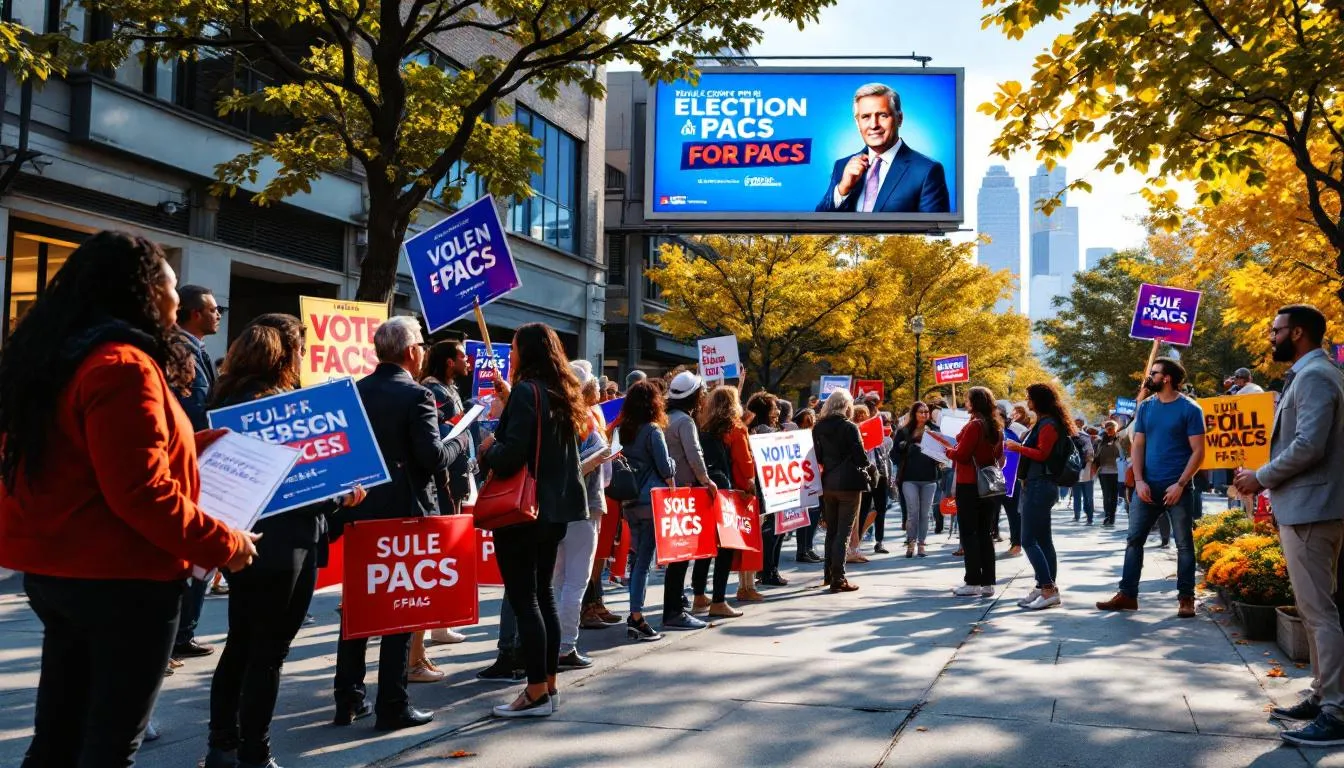Table of Contents
Quick Answer
Political Action Committees, or PACs, gather and distribute funds to influence political candidates, legislation, or ballot initiatives. In local elections, PACs hold considerable sway by using targeted strategies like paid social media advertising to shape public opinion and bolster their preferred candidates. PACs strategically leverage resources to sway voter opinions and impact election outcomes.
To understand their role in local elections, we need to examine the tactics they employ and the effects these tactics have on both candidates and voters.
What Role Do PACs Play in Local Elections?
Political Action Committees, or PACs, function like the backstage crew of a theatrical production, orchestrating strategies to ensure their chosen candidates shine. Their main goal is to influence election outcomes by supporting candidates aligned with their interests. They achieve this through financial contributions, media campaigns, and grassroots mobilization.
In local elections, PACs often focus on targeted strategies to maximize impact with limited resources. They may fund mailers, distribute yard signs, or run ads in local newspapers. Financial contributions play a crucial role, enabling them to directly support campaigns or sway public opinion through advertising. In smaller races, even modest financial backing from a PAC can significantly enhance a candidate’s ability to reach voters.
Navigating the legal framework surrounding PAC activities can be complex. At the federal level, PACs must adhere to specific contribution limits and reporting requirements, but state and local regulations vary widely. Some states have stringent disclosure requirements, while others allow PACs to wield more influence.
PACs’ involvement in local elections is fascinating, particularly when exploring real-world examples of how they leverage modern tools like social media. Understanding these dynamics sheds light on the evolving landscape of political campaigning.
How Did Kids First Newton Utilize Facebook in Elections?
Kids First Newton, a local advocacy group, offers an intriguing case study on how PACs effectively harness social media to influence elections. Driven by a mission to shape educational policies in their community, this group turned to Facebook for its advertising strategy—a platform known for its vast reach and precise demographic targeting.
Their approach was simple yet powerful. By using Facebook’s advertising tools, Kids First Newton created highly targeted ads that reached specific voter segments based on interests, age, and location. Imagine receiving a tailored ad while scrolling through your feed with your morning coffee—that’s the magic of Facebook ads.
Here’s what they did:
- Audience Targeting: They pinpointed Facebook users interested in educational issues, ensuring their message resonated with the right people.
- Engaging Content: The ads were visually engaging, using images and videos that echoed community values and concerns.
- Consistent Messaging: By maintaining a consistent message across all ads, they reinforced their stance and built a recognizable brand locally.
These campaigns were highly effective. Their message reached thousands of local voters, sparking conversations and debates within the community, amplifying their influence beyond just the ads. This strategic use of social media shows how local PACs can turn limited resources into substantial electoral impact.
What Are the Implications for Candidates?
Navigating the political landscape as a candidate can feel like a reality show—one moment you’re in the spotlight, the next you’re off the radar. This is where PACs come into play, significantly altering a candidate’s visibility and perception. When a PAC backs a candidate, it’s akin to a spotlight illuminating their campaign, potentially swaying voter perceptions. This visibility can be a game-changer, especially in local elections where name recognition is often a hurdle.
However, increased visibility comes with challenges and opportunities. PAC support can amplify a candidate’s message, providing crucial financial and strategic backing to reach a broader audience. Yet, aligning with a PAC may also tie a candidate to the PAC’s agenda, a double-edged sword if voter sentiments shift.
Ethically, candidates must proceed with caution. Accepting PAC support might raise questions about independence and influence. Voters could perceive candidates as too closely tied to special interests, which may not always align with constituents’ priorities. Imagine running for city council and suddenly being seen as a puppet of a powerful organization—awkward, right?
As we delve deeper into the political currents stirred by PACs, it’s vital to consider the broader impact these strategies have on the electorate, from shaping voter opinions to influencing turnout.
How Do PAC Strategies Affect Voters?
Picture this: you’re enjoying your morning coffee, scrolling through your social media feed, when an ad pops up. It speaks directly to issues you care about, featuring a candidate discussing local schools or traffic congestion. This isn’t a coincidence—it’s strategic targeting by PACs designed to influence your vote by focusing on what matters most to you.
PACs employ targeted advertising to nudge voter decision-making by crafting messages that resonate with specific demographics. This focused approach ensures voters often encounter persuasive content that feels personal and relevant, potentially swaying opinions or solidifying support for a candidate. It’s like a political campaign tailored just for you, delivered to your digital doorstep.
However, voter sentiment towards PAC involvement can be mixed. Some voters appreciate the influx of information and attention to local issues. Others are skeptical about the motives behind PAC-funded campaigns, wondering, “Who’s really pulling the strings here?” This skepticism can lead to distrust, as people question whether candidates represent their interests or those of the supporting PACs.
Despite these concerns, PAC activities can increase information accessibility. They highlight issues that might otherwise go unnoticed, prompting voters to research and engage with local elections more deeply. This increased awareness can empower voters to make informed decisions, even as it raises questions about the sources and intentions of the information.
What Are the Broader Consequences of PAC Involvement?
PACs can significantly reshape the local political landscape, often in ways not immediately visible. Imagine your hometown, traditionally dominated by a few key players. Now, introduce a PAC with substantial resources and a clear agenda. Suddenly, the dynamics shift. This new player can elevate candidates who might otherwise struggle, altering the balance of power and potentially changing the political dialogue.
The long-term effects of PAC involvement can be profound, influencing democratic processes and voter engagement. On one hand, PACs can invigorate local politics by injecting issues into public discourse and mobilizing previously disengaged voters. I recall a local election where a PAC-funded campaign highlighted environmental issues, leading to higher voter turnout and a more informed electorate. However, this isn’t always positive. There’s a risk that the loudest voices, backed by the deepest pockets, drown out grassroots movements, skewing representation in favor of well-funded interests.
This raises questions about regulation and transparency. Clearer rules and greater transparency in PAC activities are crucial for maintaining fair elections. When voters can see who’s funding campaigns and why, it helps build trust in the electoral process. At a community meeting, I heard local residents express concerns about the opaque nature of some PACs, calling for more stringent disclosure requirements to ensure local elections reflect community values.
As we consider these broader consequences, it’s crucial to think about actionable steps that balance influence and integrity in our democratic systems.
Key Takeaways
- PACs wield considerable influence in local elections through strategic advertising, such as targeted social media campaigns.
- The Kids First Newton case demonstrates how effective use of platforms like Facebook can amplify a PAC’s message.
- Candidates benefit from increased visibility with PAC support but must balance this with the potential for perceived bias.
- Voters receive more information but may question the motives behind PAC-driven campaigns.
- Ongoing discussions about the ethical and regulatory aspects of PACs continue to shape the political landscape.
Let’s stay informed and engaged, ensuring our voices contribute to shaping the future of our communities.







